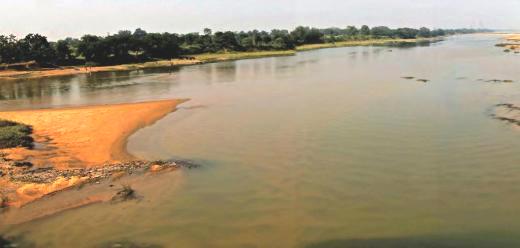By Sabyasachi Amitav
The fight between Odisha and Chhattisgarh over projects in the upstream of river Mahanadi, has intensified further with Centre failing to resolve the dispute and BJD Govt in Odisha trying to polarize people on this emotional issue. But the question is Mahanadi, whose river is it anyway? Does it belong to both Odisha & Chhattisgarh, or belongs to BJD & BJP? The issue has now snowballed into a major controversy and reached Delhi.
Mahanadi, the lifeline of Odisha is in danger. The large dams being built on the River Mahanadi in Chhattisgarh have become highly controversial. Both the Chief Ministers are engaged in a war of words, political parties have started agitations and the water issue is fast turning into a highly emotional affair. The downstream state, Odisha, vehemently opposes upstream Chhattisgarh’s ongoing construction of a series of barrages to utilise the larger share of the Mahanadi waters in its catchment area.
Odisha is predominantly an agrarian economy and about two-thirds of the population depends on agriculture. The river is the lifeline for 16 of its 30 districts. The Mahanadi delta covers 95,000 sq. km and the delta region has a 200km coastline. The availability of safe drinking water and sanitation largely depends on Mahanadi. Also, Odisha is a cyclone-prone state and the mangroves in the delta are the first line of defence against the sea. Adequate water in the Mahanadi is an important prerequisite to maintain the fragile eco-system
The Mahanadi river basin’s total catchment area is close to 141,600 square kilometers, of which 53.9 per cent falls in Chhattisgarh, 45.73 per cent in Odisha and 0.35 per cent in Madhya Pradesh. During the monsoon, the Mahanadi has a discharge rate of 57,000 cusecs, almost the same as the Ganges, but in the dry seasons, it turns into a narrow channel.
Before the construction of Hirakud Dam in 1953, the river was infamous as the “sorrow of Odisha” owing to the massive floods it caused. Heavy rain still floods the river’s basin, but the deluge is not as frequent and devastating as before.
An average inflow of Mahanadi at Hirakud dam in Odisha is 40,773 MCM, out of which 35,308 MCM comes from Chhattisgarh.
The latter claims it is presently using only 9,000 MCM of the waters, so for its own economic needs, it is well within its right to exploit more of the basin’s capacity. Chhattisgarh further argues that its projects are primarily aimed at providing water for non-consumptive industrial use.
On the other hand, Odisha claims that Chhattisgarh has already constructed three barrages unilaterally, which affected the flow of water to Hirakud Dam during the dry spells.
Odisha’s Objection?
- Chhattisgarh has taken up construction of many major and medium projects on the upper Mahanadi without consulting Odisha. The construction of seven barrages poses a serious threat to the non-monsoon (September to June) water flow to the Hirakud reservoir. Chhattisgarh projects them as minor schemes, but these are meant for industrial purposes.
Once the projects are complete, flow to the downstream will reduce. This will affect the fragile ecosystem of the Mahanadi – particularly the Satkosia, Bhitarkanika wetlands, Chilika lagoon, Gahirmatha turtle habitat and the Mahanadi delta itself. Drinking water supply in the state will also be affected
Raman’s Mahanadi stand:
All projects on the Mahanadi have been built following the rules of the state. Even after its proposed (disputed) projects are completed, enough water will remain in Mahanadi to fill the Hirakud dam roughly 5-7 times.
Centre’s stand
Centre told the Supreme Court that there is no need to constitute an inter-state tribunal in the dispute between Odisha and Chhattisgarh over sharing of river Mahanadi water.
In a submission made through an affidavit before the apex court, the Centre shifted the blame on Odisha government for failing to provide relevant facts and figures required for constitution of such tribunal despite several attempts by it to seek those.
Option before Odisha
Decision of Supreme Court on water dispute tribunal formation.
However, if we look at the past experiences, particularly on the Cauvery, Krishna, Yamuna and Sutlej river basins, New Delhi has not exactly been successful in adjudicating inter-state water disputes.
Odisha has been the primary user of the Mahanadi for many decades, while Chhattisgarh has been the major contributor. Odisha cannot demand to protect its historic right to water use as this principle does not get anymore precedence over Chhattisgarh’s demand for equitable use under the recently promulgated international law for trans-boundary Rivers.
To its credit, Chhattisgarh has been smart in declaring its water projects for industrial use and not for irrigation purposes. That helps strengthen Chhattisgarh’s claim as industrial water use is not highly consumptive and can possibly be reused in the river system.
Lastly, the enclosure of the water commons – the inevitable outcome of these dams – will have a devastating impact on the lives of millions, especially the rural poor who depend on the water commons in multiple ways for their living. What is occurring in the Mahanadi Valley today is resistance by a riverine people against powerful elites bent on pursuing a strategy of accumulation by dispossession, and trying to turn their rivers into free fuel for industrial plants, in utter disregard of the impact on their lives and livelihoods.
(The writer is a Bhubaneswar based Journalist, Twitter handle: @tvjournoamitav). Cell: 9438296519

